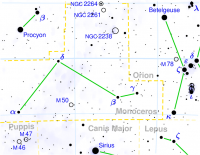CoRoT-7
Da Ufopedia.
| Riga 1: | Riga 1: | ||
{{Tradurre}} | {{Tradurre}} | ||
| + | [[Immagine:771px-Monoceros_constellation_map.png|thumb|right|200px|Costellazione dell'Unicorno.]] | ||
'''COROT-7''' ('''TYC 4799-1733-1''') is a [[Apparent magnitude|magnitude]] 11.7 [[main sequence]] [[orange dwarf]] [[star]], and thus is slightly smaller and cooler than the [[Sun]]. This star is located in the [[Monoceros constellation]].<ref name="symp09">{{cite web | '''COROT-7''' ('''TYC 4799-1733-1''') is a [[Apparent magnitude|magnitude]] 11.7 [[main sequence]] [[orange dwarf]] [[star]], and thus is slightly smaller and cooler than the [[Sun]]. This star is located in the [[Monoceros constellation]].<ref name="symp09">{{cite web | ||
| title=CoRoT-exo-7b Has CoRoT discovered the first transiting Super-Earth around a main sequence star? | | title=CoRoT-exo-7b Has CoRoT discovered the first transiting Super-Earth around a main sequence star? | ||
Versione delle 07:35, 19 set 2011
| Questa voce ha bisogno di essere tradotta. |
COROT-7 (TYC 4799-1733-1) is a magnitude 11.7 main sequence orange dwarf star, and thus is slightly smaller and cooler than the Sun. This star is located in the Monoceros constellation.[1]
Indice |
Location and properties
The star is located in the LRa01 field of view of the COROT spacecraft. According to the project website this field is in the Monoceros constellation.[1] The discovery paper lists the stellar properties as being a G9V type star with a temperature of 5275 K, a radius of about 87% of the Sun and a mass of about 93% of the Sun. The star has roughly the same amount of metals as the Sun: the quantity [M/H], which is the base-10 logarithm of the ratio of the star's metal abundance (given by the ratio of metals to hydrogen) to that of the Sun is 0.03 ± 0.06, which corresponds to a range 93% - 123% of the solar metal abundance with a best fit value of 107%. The star is estimated to be about 150 parsecs away and with an age in the range 1.2 – 2.3 billion years, is younger than our own star which has an age of 4.6 billion years.[2]
This star has been reported to be seismically active, making the confirmation process for the planet more difficult.[3]
Planetary system
The star is reported to be orbited by the super-Earth extrasolar planets COROT-7b and COROT-7c.[4] The discovery of the inner planet was made using the astronomical transit method by the COROT program. CoRoT-7b is notable for its small reported size.[5]
Template:PlanetboxOrbit begin Template:PlanetboxOrbit Template:PlanetboxOrbit Template:PlanetboxOrbit end
See also
- COROT - an operational French-led ESA planet-hunting mission spacecraft, launched in 2006
References
External links
Errore nella funzione Cite: Sono presenti dei marcatori
<ref> ma non è stato trovato alcun marcatore <references/>
